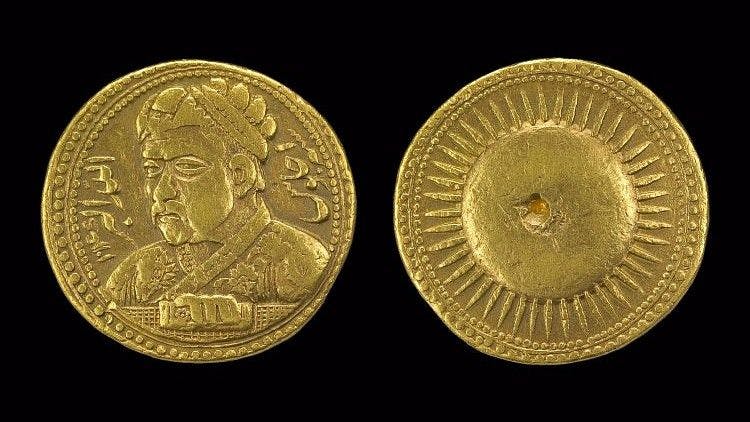‘Scandalous’ Coins of Jahangir
BOOKMARK
In the world of numismatics or the study of coins the appearance of Mughal Emperor Jahangir’s coins always causes a bit of a sensation. These are prized by experts and coin collectors all over the world for their uniqueness and rarity. Unique because they were different from any coins minted before or after by Islamic rulers and rare, because they really scandalized the orthodox clergy in Mughal India... so much so that Jahangir’s son Shah Jahan ordered these coins to be melted. He even ordered the death penalty to anyone who used or possessed the coins minted during his father’s time!
Jahangir took over the reins of the Mughal Empire after his father Akbar died in 1605 CE. Though mostly portrayed as a debauched, opium addict Jahangir did carve a niche. He was a great open-minded, aesthete and connoisseur of the arts. A man with an insatiable appetite to learn about the world, Jahangir is famous for the many folios of the flora and fauna of the subcontinent, that he commissioned.
But his taste for experimentation and his distaste for orthodox beliefs also ticked off the orthodox and powerful Muslim clergy.
Soon after taking charge, Jahangir was the only Mughal ruler to have issued coins with portraits on them. The pictorial depiction of ‘living things’ is considered as taboo in orthodox Islam. Since the time of Qutubuddin Aibak, all Islamic rulers in India, only used calligraphic inscriptions on their coins. However, Jahangir broke this tradition with his ‘portrait’ coins.
Immediately after his father Akbar’s death in November 1605 and even before his own formal coronation in March 1606, Jahangir commissioned coins with portraits of his late father, Akbar. Then between 1611 CE to 1614 CE, much to the horror of the orthodox Islamic clergy, he went on to mint coins with his own portrait, something no Islamic ruler in India had ever done before. These ‘portrait’ coins varied. Some showed Jahangir resting his hand on a balcony, holding cup of flower or seated cross legged on the throne with a Lion on the reverse. It is important to note that these coins were not used as currency but were commemorative coin given by Jahangir.
Among these special coins commissioned by Jahangir, the most beautiful and unique were the so called zodiac coins which were very ornate. In his memoir, Tuzk-i-Jahangiri, Jahangir writes that it occurred to him to replace the name of the month, which was being written on the reverse of the coins, by the figure of the corresponding constellation. He issued an attractive series of coins in gold and silver representing the twelve zodiac constellations. In fact, the original copy of the Tuzk-i-Jahangiri, contains each of these original designs.
However, there is a subtext to these coins as well. Professor Ellison Banks, a historian from Trinity College, Connecticut, in her book ‘Nur Jahan: Empress of Mughal India’ points out that it was the influence of Nur Jahan which made Jahangir mint these coins. Jahangir married Nur Jahan in 1611 CE and slowly and steadily her power and that of her family was rising in the Mughal empire
By 1623, Nur Jahan had gained complete control over the empire and to cement her position even further, she began issuing the coins in her name which were called ‘Nur Jahani coins’. These were issued from imperial mints at Agra, Ahmedabad, Allahabad, Lahore, Patna and Surat. These Nur Jahani coins bear a couplet:
Zi hukm Shah Jahangir yaft sad zewar
Ba-nam Nurjahan Badshah Begum zar
(By the order of Shah Jahangir gold attained a hundred beauties when the name Nurjahan Badshah Begum was placed on it)
It was a bold declaration of power by Nur Jahan and perhaps a mistake. Her stepson Prince Khurram was preparing to take control of the throne, helped by his father-in-law and Nur Jahan’s brother Asad Khan. Following Jahangir’s demise in 1627, Prince Khurram emerged victorious after a brief but decisive battle of succession and so ascended the throne, taking the title, Shah Jahan. Nur Jahan, the powerful former Empress meanwhile, had to spend the rest of her days in house arrest.
Soon after coming to the throne in 1628 CE, Emperor Shah Jahan ordered the murder of all his male cousins. He already had his elder brother Prince Khusro murdered in 1622 CE. Perhaps it was the guilt for these deeds and the desire for legitimacy, that Shah Jahan made a pact with the orthodox Islamic clergy at court. To placate them, he banned the use of Jahangir’s portrait coins, the Zodiac coins as well as the Nur Jahani coins. Anyone found to be in possession of these coins was given capital punishment. As a result, most of these coins were melted and destroyed.
Today, the few surviving coins of Jahangir are highly prized by collectors around the world. In 2016, a Nur Jahani gold coin fetched Rs 76 lakhs at a Mumbai auction, while in New York, in the same year, the Scorpio Zodiac coin of Jahangir was sold for a whopping Rs 3.11 crore!
Today, some of these rare coins are on public display and can be seen at the National Museum in New Delhi as well as the Reserve Bank of India Museum in Mumbai.
Image Courtesy: British Museum, COIN INDIA










